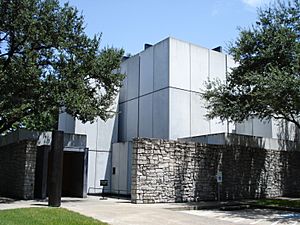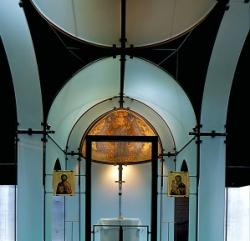Byzantine Fresco Chapel facts for kids

The exterior of the Byzantine Fresco Chapel in Houston
|
|
| Lua error in Module:Location_map at line 420: attempt to index field 'wikibase' (a nil value). | |
| Established | September 1997, reopened 2015 |
|---|---|
| Dissolved | 2011 |
| Location | Houston, Texas, U.S. |
The Byzantine Fresco Chapel was once a special part of the Menil Collection in Houston, Texas. It was located near the University of St. Thomas. For many years, from 1997 to 2012, it showed off some amazing Byzantine frescoes. These were large, important wall paintings, and they were the only ones of their kind in the Western Hemisphere.
These beautiful frescoes originally came from the church of St. Evphemianos in Lysi, Cyprus. They were taken from Cyprus in the 1980s. In 2011, it was announced that the frescoes would go back home to Cyprus. This happened in February 2012, after a long agreement with the Greek Orthodox Church of Cyprus ended. The church, which owned the frescoes, decided not to let them stay on loan any longer. They couldn't go back to their exact original church because Lysi is now in Northern Cyprus. Instead, they are now displayed at the Byzantine Museum in Nicosia. The Byzantine Fresco Chapel closed in March 2012. However, it reopened in 2015 to host new art projects.
Contents
A Look at the Chapel's History
The chapel first opened its doors in February 1997. It proudly displayed incredible artworks from the 13th century. These included a dome painting of Christ Pantocrator and an apse painting of the Virgin Mary, known as the Panagia.
These frescoes had a dramatic story. They were stolen from a chapel near Lysi, in a part of Cyprus that was occupied in the 1980s. The thieves cut the paintings into 38 pieces. They then shipped them to Germany to sell them illegally. The Menil Foundation, based in Houston, bought these 38 pieces from the thieves. They did this on behalf of the Church of Cyprus, who were the true owners. The Menil Foundation then paid for the careful restoration of these ancient paintings. These fully restored frescoes were truly special and unique in the Western Hemisphere.
The Original Artworks
The main artworks in the chapel were the frescoes from the dome and the apse. The dome showed Christ Pantocrator, which means "All-Sovereign." This painting created a feeling of endless space. Christ's direct gaze seemed to look beyond time itself. He was shown from the bust up, making him feel universal and everywhere.
Around Christ, there were two rows of angels. They were moving towards a special throne prepared by God the Father. This throne was for the Second Coming of Christ. The Archangel Michael and Archangel Gabriel guarded the throne, along with two seraphim. The Virgin Mary led one line of angels, while John the Baptist led the other.
In the apse, the Virgin Mary was painted with the two archangels beside her. On her chest was a medallion of the infant Christ. This symbolized the Incarnation of Christ, meaning when God became human.
New Art Projects
After the frescoes returned to Cyprus, the Chapel started showing different art. One exhibit was called The Infinity Machine. This artwork was created by Janet Cardiff and George Bures Miller. It featured antique mirrors that rotated from the ceiling. It also included sounds made from NASA recordings of solar winds in space.
The Chapel's Design
The building itself was designed by architect François de Menil. It was about 4,000 square feet and cost $4 million to build. The inside of the chapel used rough stone, frosted glass, and rich woods. This mix created a space that felt both like an art museum and a spiritual place.
The glass "walls" inside were not copies of the original chapel in Cyprus. Instead, they created a new way to display the ancient artworks. De Menil wanted to avoid simply copying the old chapel. He designed an outer building that acted like a "reliquary box." This box held a separate, freestanding chapel inside. This design created a neutral and special place for the frescoes.
The Byzantine chapel faces the main compass directions: north, south, east, and west. The enclosed space is about 116,000 cubic feet. There are no windows on the sides of the building. However, a large skylight, about 1,012 square feet, lets natural light fill the inside. The rough limestone wall on the outside of the building reminded visitors of the simple construction of the original chapel in Cyprus.
See also
- John de Menil
- Dominique de Menil


